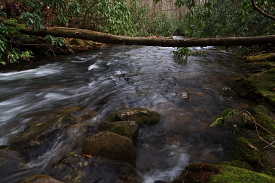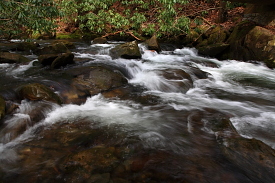| Joyce Kilmer
Memorial Grove Trail
Location: Joyce
Kilmer-Slickrock Wilderness, Nantahala National Forest, North Carolina
March 8, 2011 After hauling our overnight packs back down the mountain and stashing them at the car near the trailhead, Andra and I took nothing with us but a camera as we strolled up the shorter Joyce Kilmer Memorial Trail, the one with the old growth tuliptrees. The first tuliptree I ever saw was in Fort Collins near the northwest corner of Oak and Shields, and I believe that is the largest tuliptree on the Front Range of Colorado, where the tree is neither native nor successful. I tried growing one myself in Colorado, and it did well for 3 years, attaining a height of some 15 feet, only to die as soon as I moved away to another part of town. But to see the native tuliptrees on the Cumberland Plateau and throughout the Appalachian highlands of the midsouth is to see the tuliptree at its best, I think, and certainly at its largest. Apparently nowhere is there such a concentration of massive old-growth tuliptrees than in the Joyce Kilmer Memorial Forest, a small tract of land on Little Santeetlah Creek in North Carolina that was somehow spared the wave of logging that swept over the eastern US in the late 19th and early 20th centuries. Joyce Kilmer was a poet who wrote “Trees”, a poem that is short, direct and an expression of natural beauty that, while a common theme today, was not so common in the industrialist age in which it was penned. I confess I do not find the poem particularly inspirational and am a bit surprised at its long-lasting, widespread fame. I think that its endurance stems more from the cutting-edge view of nature that it expressed, coupled with the poignancy of the juxtaposition of this simple quiet sentiment with Joyce Kilmer’s gruesome death on the western front in WWI amidst hellish trench warfare in a battered landscape denuded of trees. I imagine that near the end of his life, amidst the carnage, his own memories of lush peaceful forests stood as bitter irony to the situation he found himself in. There are several trailhead placards detailing Joyce Kilmer’s life and the history of this forest that make interesting reading. After musing over these for a little while, we crossed over Little Santeetlah Creek, a bubbling brook lined with glossy green mountain laurel leaves, as we headed on up the trail. The dead hemlocks are impossible to ignore. These giant trees reaching some 150’ in height that dominated the lowlands along the creek just a decade ago are now all dead, victims of the introduced Japanese hemlock wooly adelgid, and they are literally falling apart. Chunks of tree crown as big as telephone poles tumble down in high winds, and to ameliorate the hazard, resource managers felled most of the trees, not by saw, but by dynamite. The effect was supposed to look more natural than sawn stumps, and I believe it will, someday. For now it looks like resource managers blew up hundreds of trees with dynamite. I approve, but I find it humorous that chainsaws are not allowed in the wilderness, but dynamite is OK. It sort of puts me in mind of some plot hatched by Wiley Coyote to kill roadrunner by felling a tree across the trail. You can picture it, right? There’s not much funny about the wider implications of the wooly adelgid, however, as it is extirpating hemlock across the eastern US, much like pine bark beetle is mowing down millions of acres of pines in the western US (see the extent in this USFS map). We walked past the dead leviathans, and we gained elevation above the creek, and passed out of the old haunts of the hemlocks, we returned to normalcy in the forest. The leaves had not yet sprung out on any of the trees, and I’m sure the effect of fully-leafed giant tuliptrees is more serene than the austere naked branches we were witnessing. Yet if the effect was stark, the advantage was in the ability to visualize entire trees, buttress to crown, from a great distance without our line of sight interrupted by interceding trees. The tuliptrees were impressive, as how could they not be? At breast height, trunks were 4 to perhaps 6 feet in diameter. I paced off the circumference of one particularly large tree at 30 feet. By pairs and triads, they marked the forest like sentinels, mammoths that dwarfed hickory and maple trees that under any other circumstances would be considered very large themselves. We passed by the stone memorial to Joyce Kilmer, above which a very large tuliptree had broken in half. The trail formed a second loop that started and stopped at the memorial rock, and the most impressive trees lay in this upper loop. I stopped so often to admire the trees and take pictures, it took us more than an hour to cover the 1 mile loop. From the memorial rock, we headed back to the car on the final leg of the figure 8 loop, intersecting the Naked Ground trail just past Little Santeetlah Creek, where we had trundled down from the upper reaches of the watershed earlier in the morning. Again, we passed by dozens of splintered hemlocks along the trail. It appears that they did this work just last fall, as the vegetation looks very recently disturbed. It’ll be nice in a few years when vegetation grows over the trunks and fills in the bare patches left by the forest crews. |
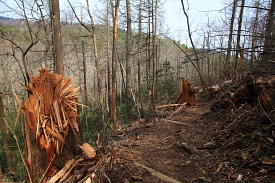

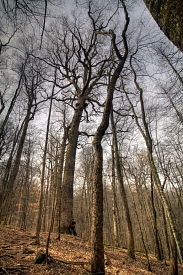
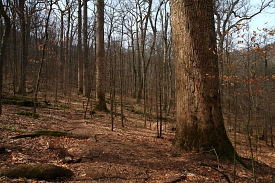
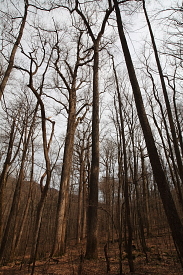
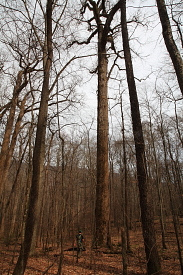
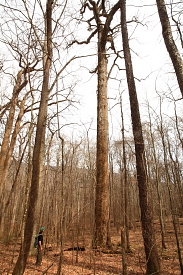
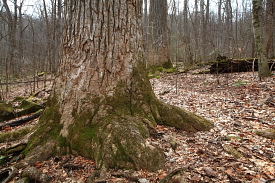
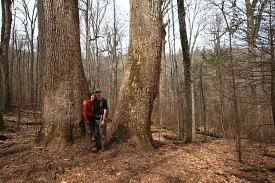
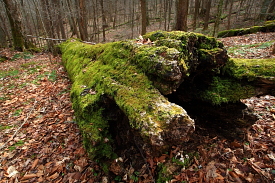 |
